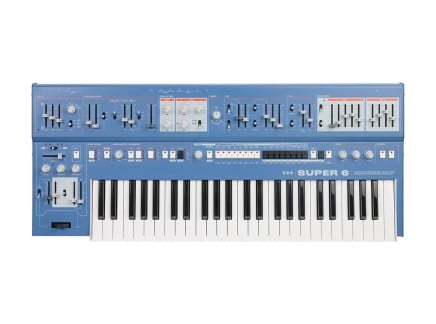The UDO Super 6 is not exactly new on the scene—it was announced some time ago, and has been previewed at trade shows ever since to great fanfare. But, despite its overwhelmingly warm reception, the (new) manufacturer UDO has, as of yet, not started shipping them. Having now spent time with a new production unit, it is easy to tell why. UDO has taken their time because they needed the instrument to be flawless, and for my purposes, they have succeeded.
The Aesthetic and Build
At a quick glance, one could mistake the Super 6 for a vintage Roland synth...perhaps a member of the Juno or Jupiter family. Its panel layout feels immediately familiar, and many features (down to the orientation of the performance controllers) seem like an obvious nod to these much-loved classic instruments. This visual aesthetic certainly implies a number of things to synthesists familiar with the ethos of classic Roland instruments—and while you'll definitely find the lush, swarmy chords you'd expect from a Juno, you'll find much more hiding inside as well.
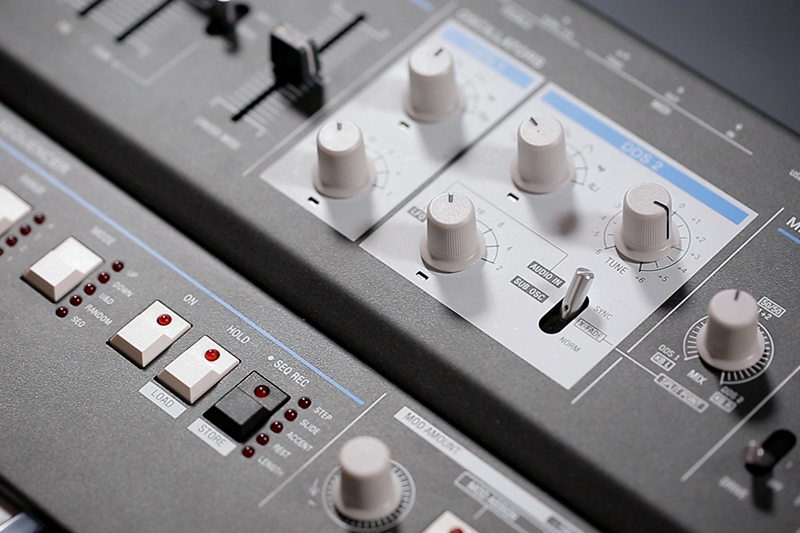 The DDS oscillator section on the UDO Super 6
The DDS oscillator section on the UDO Super 6
The attempt to provide this instrument a "timeless" visual aesthetic seems to change the way that you see it and interact with it: it truly feels like an instrument with a revered history (albeit a history that hasn't happened quite yet). I have no doubt that in thirty years, these synthesizers will still be every bit as useful and entrancing as they are now.
And perhaps most cleverly, by employing this "timeless" aesthetic, UDO draws attention away from some of the potential hype and buzzwords they could have deployed to describe its truly cutting-edge design, positioning it as an instrument that will continue to be useful rather than fancy new technology that will eventually become obsolete. Rather than using flashy displays or trademarked buzzwords, they let the instrument remain a bit understated...and in doing so, keep it from feeling like something that will go out of style once technology inevitably progresses. Is it a "12-Voice Polyphonic Binaural Analog-Hybrid Synthesizer with Super-Wave Technology"? Yes, and it does say so on the panel—but in a clean, unobtrusive way that keeps attention where it belongs: on the synth itself. And when using the synth, all of the fancy technology employed becomes completely transparent, as if you're just using a classic and familiar polysynth.
And while its sound engine is well worth discussion (we'll get to that shortly), this isn't just some fancy code slapped into a box and called a finished product: UDO have paid attention to every detail and made no obvious compromises. The enclosure feels solid, the keybed feels great to dig into, the sliders are smooth, and the switches have a satisfying click. In a world with countless as-miniaturized-as-possible plastic instruments, something designed specifically to never feel outdated is a rarity.
If you get your hands on this synthesizer, you're not going to want to take them off.
So What is the Super 6?
So, build quality and ethos aside, what exactly is the Super 6? In short, it is a hybrid synthesizer with a fully stereo signal path, from the oscillators and filters to the final effect section. And perhaps most interestingly, rather than constructing the stereo image by panning monaural sources, the Super 6 instead relies on swarmy phase separation effects built into the oscillators themselves, as well as clever schemes of phased stereo LFO modulation. This breaks past the one-dimensional sound of mono-to-stereo panning and instead produces effects not dissimilar to the way we hear in three-dimension space: sound arrives at our ears at slightly different times, with slightly different levels of coloration. By providing direct and intuitive access to the building blocks of these psychoacoustic tricks, the Super 6 creates an immersive, inexplicably huge-sounding stereo image that feels like it wraps all around you.
A Stereo Playground
The sound starts with the two DDS oscillators, each with their own sonic flavor. It's important to note that these oscillators are not DSP based—they're FPGA-based. This enables an uncommonly high sample rate, providing a sonic crispness and clarity that somehow feels analog despite technically being digital. The first oscillator (DDS1) at a glance offers fairly straightforward functionality: it can produce sine, saw, square, triangle, noise, and a number of wavetable-based shapes. When put into "Super" wavetable mode, this oscillator suddenly produces six sister oscillators that are each dynamically detuned and de-phased in the stereo field, creating a tone that even with no modulation applied feels like it is swirling in circles. This sound feels like a mix of a supersaw and a classic swirling Roland chorus—but much more clean and clear, avoiding the murkiness and hiss of traditional chorus effects. The Super 6 comes with several wavetables saved, but also supports user download of additional waveforms...though full details about this feature have not emerged as of yet.
DDS2, also FPGA-based, provides a somewhat more straightforward set of oscillator sounds: sine, saw, square, triangle, noise, and pulse waves, as well as a sub oscillator. DDS2 can be detuned from DDS1 and even set to LFO ranges for additional modulation duties (but more on that in a bit). The two oscillators can be blended together using a dedicated mix crossfader—which in performance can become a handy tool for continuously fading between separate sonic textures, not unlike a DJ crossfader. The oscillators can also be cross-modulated, creating gnarly, howling FM textures.
Then the sound passes to the filter section. At this point, the signal path becomes analog—using a mix of discrete components and VCF and VCA ICs from SSI. The VCF is a four-pole lowpass filter with resonance that extends into self-oscillation. The filter also features two different overdrive modes: one subtler level of drive meant largely to provide bass compensation at higher resonance settings, and one more intense drive for extra grit and color. You can also introduce a highpass filter at a fixed frequency, or may link the highpass filter to the lowpass filter's cutoff frequency—in which case they form a bandpass response. The filters do accurately track the keyboard, so it's possible to use them as an extra melodic sound source as well. The sound then passes through analog VCAs and then through digital effects running at 24-bit 192kHz.
But What is Binaural Synthesis?
Before getting too deep into the stereo features, it's important to talk about the Super 6's polyphony. In truth, the Super 6 can operate as a 12-voice polysynth; but we suspect that many will opt to use it in its six-voice mode. When you switch the synth into Binaural mode, however, a world of new possibilities emerge...including the aforementioned full stereo operation. This effectively halves the polyphony by allocating pairs of voices to each ear—and UDO refers to these pairs of coupled voices as "Super" voices. The Super voices allow for tons of tricks difficult to achieve on synths with more traditional architectures. And largely, this is achieved through clever use of modulation.
Let's say you have two identical saw waves going through two identical filters, then to two identical VCAs and out to two separate speakers. If identical modulation is applied to each oscillator, filter, and/or VCA, then the net effect is a basically monophonic output: despite the fact that there are two separate signal paths, they sound the same as one another. There are a lot of ways to twist this architecture into something stereo—and the Super 6 does basically all of them. There's the aforementioned "Super Wavetable" trick—but then there's something equally compelling: stereo modulation.
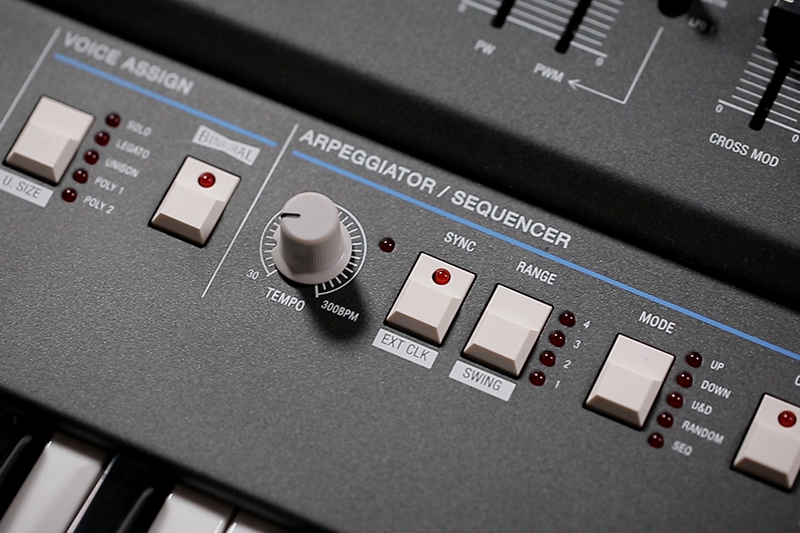
The Super 6's first LFO is a super clever design built for stereo modulation. It provides triangle, square, random, and saw shapes, as well as two high frequency sine wave modes. It provides a dedicated rate slider and a dedicated attack-only "delay" envelope (for classic Roland-style delayed vibrato, filter modulation, and more). But the coolest part is the parameter called LR Phase. Since each Super voice technically has two LFOs hiding behind the LFO1 panel controls (one for each voice that comprises the Super voice), UDO has added a phase control that allows you to separate the phase of the two LFOs. The rate and delay of the two LFOs remains linked—allowing for a lot of effects from relatively standard panning tricks to much more bizarre techniques.
Let's think for a moment about amplitude modulation. Let's say you assign LFO1 to a Super voice's VCA level—if LR Phase is set to its minimum value, the left and right LFOs will be the same as one another. Applying this modulation to the VCA will produce a tremolo effect. By increasing the LR Phase control, you'll introduce more phase separation between the left and right LFOs...and since the tremolo effect is now occurring at different times in the left and right channels, it produces a panning effect. With LR Phase set in the middle position, this will create a smooth, continuous panning effect; when set to maximum, the effect will again be a simple tremolo; and in between, the panning "waveform" will seem to change.
This simple trick can also be applied to other parameters: the oscillators' pitch (creating further bizarre vibrato and chorusing effects), delay rates, the filter cutoff...and while each of these techniques might seem mundane when used in mono, applying this type of phase-displaced stereo modulation breathes new life into them, creating bizarre psychoacoustic dampening effects, animated swirls, and rich timbral movement from simple components. Stereo filter or VCA modulation begins to take on a life not unlike the swirling chorus—and the running theme of this synthesizer becomes even more clear: it is a instrument with a vast toolkit for creating an almost tactile sense of sound in space.
Another detail worth noting about LFO1: it can go well into audio range, and can even track the keyboard (in HF and HF TRK modes). This becomes an interesting potential source of modulation, especially with LR Phase adjusted to an interesting value. It begins to take on an effect less like panning and more like a type of positioning based on bizarre phase differences between both audio channels. It's a bit difficult to describe, but has an interesting smearing/widening effect that is at once visceral and disorienting. Also, when in the high frequency modes, the LFO can be added to the audio signal path, making a third oscillator. Similarly, DDS2 can run in LFO range and modulate the filter and many other parameters. This synth is full of similar creative workarounds, and it feels like UDO have really spent time thinking about just how much they could get out of every single section.
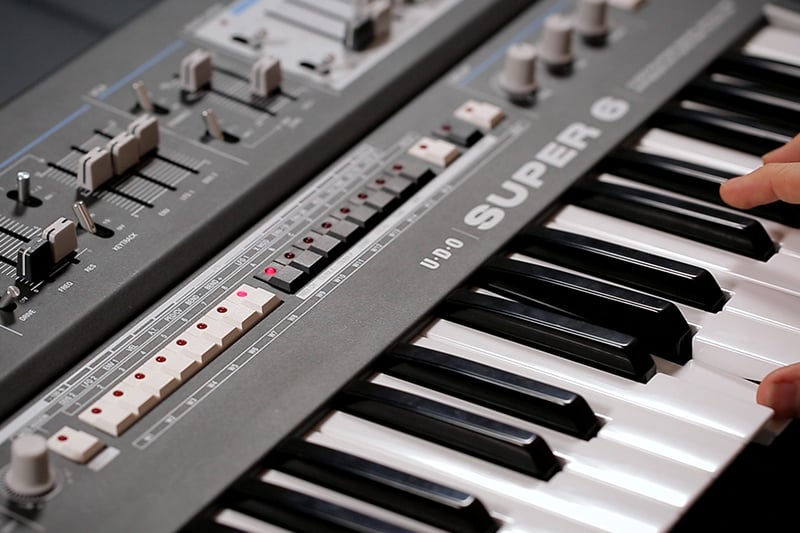
A fun and nerdy detail: the LR Phase parameter is labelled as having a range of 0–2pi, indicating that the designers are thinking of phase displacement in radians. This makes a lot of sense in terms of constructing sine waves from linear phasors—by offsetting a phasor with 2pi magnitude up to 2pi and then evaluating the sine of the phasor's current position, you'll maintain a clean sine wave, just one displaced from the original phasor's phase by up to 2pi radians (or 360 degrees). Using radians also feels like it indicates that they are truly thinking of rotation as fundamental to the instrument's design: especially apt on a device so centered around the concept of rich spatial movement.
Of course, there's much more to the modulation than just LFOs—though LFO1 definitely has the strongest potential for creating stereo movement. There is, in fact, a second LFO as well. The first envelope can loop, and the keyboard is sensitive to velocity and mono aftertouch—and when paired with an appropriate controller, Super 6 can also respond to MPE.
High-Quality Internal Effects
And in situations where you need all twelve voices to be independent, there are still plenty of ways to create stereo movement the old-school way: with an excellent effect section. But like the rest of the Super 6's architecture, the effects provide a deceptively simple interface for something remarkably refined and musical.
The delay provides control for rate, feedback, and level. While wholly digital, it provides an uncommonly high sample rate (192kHz 24-bit) and sounds remarkably clean and transparent. The rate control has a pleasant slew to it, providing classic BBD-style pitch bends and warbles when twisted or modulated...but without the clocking noise and murky frequency response. At high feedback, the delay approaches near-infinite repeats without the crunch and breakup of analog delays—making it great for accumulated sound-on-sound textures. And the delay section itself is stereo—so with clever modulation, you can use it to augment the sense of space considerably, and can use it to produce dramatic pseudo-flanging and chorusing effects at relatively fast rates.
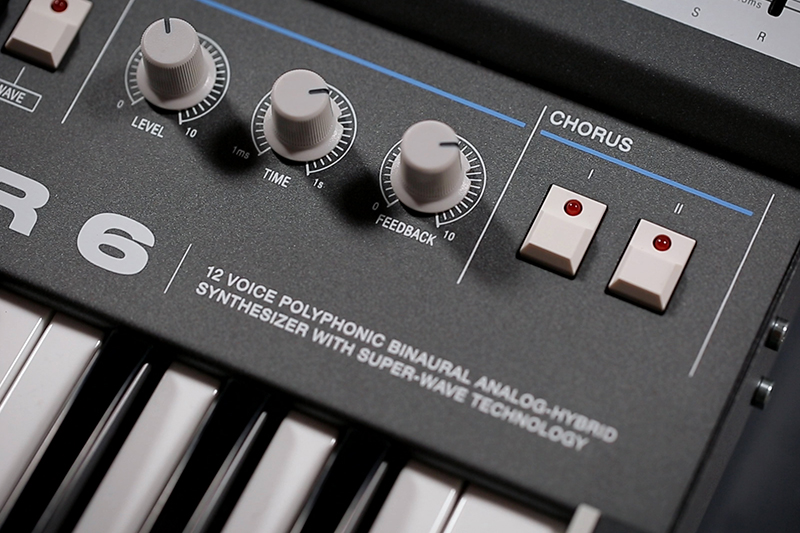
And of course, another homage to the Roland synths of yesteryear: the chorus section. The Super 6 features three chorus modes clearly inspired by the Juno family—but, as with the rest of the synth, these provide a level of refinement well beyond a simple BBD-based chorus. The chorus section is based on six delay lines set to very intentional modulation phase relationships and stereo position. Chorus mode I is subtle and adds a bit of shimmer to your sound; Chorus mode II is a much more intense, wet, swirling effect (not unlike an exaggerated re-imagining of what a classic Roland chorus is like). Mode III is especially shimmery, and feels truly like a classic ensemble-style effect, turning raw filtered saw waves into rich sections of strings. Whether you want subtle widening, rich chorusing, or swirling, swimming, dripping-wet modulation effects, this chorus section is up for the job—and somehow, as with their spiritual ancestors, the two-button interface is more than enough to do everything you need.
There is more to the Super 6 than we can address in a single article. The modulation matrix is deep and intuitive; the left-hand controller section provides the potential for expressive sonic inflections (oh, and the bender is even available as a source in the mod matrix). The arpeggiator has a playable immediacy, and the keybed itself is a delight to play.
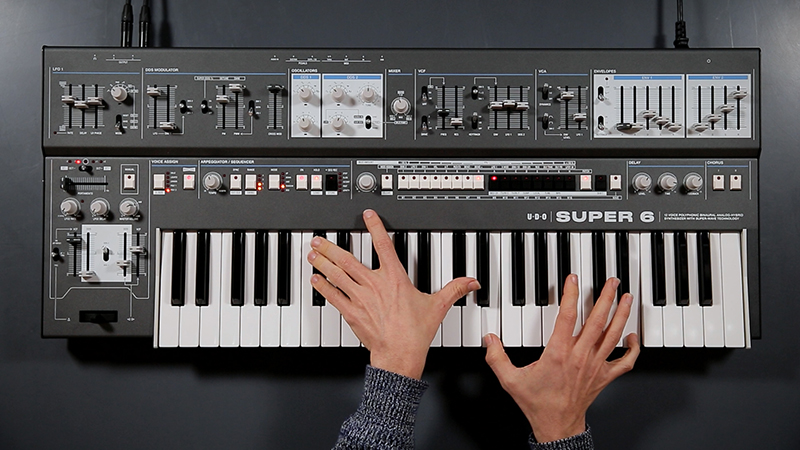
While at a glance the feature set may seem modest, this is an uncommonly clever synth design. Just when you think you need one more LFO or one more sound source, this instrument has a way of kindly revealing a solution. It's difficult to describe, but in my own experience, the act of going from idea to sound on the Super 6 is uncannily fluid. For me, the interface has exactly the right combination of familiarity and intrigue. And when these magic ingredients are combined with its many ways of creating compelling, engrossing, and visceral spatialized sounds, it becomes easy to get carried away following the sound—and I mean that in the best possible way.
Despite being a new company, UDO clearly have the experience and perspective necessary to have produced a remarkable instrument. From the cutting-edge signal architecture to the nostalgic-yet-futuristic physical design, the Super 6 is a bold entry into the musical marketplace. It's been a long time coming, but having spent some time with it, I can confidently say that it is well worth the wait. The Super 6 is an incredible instrument; and it will continue to be so.

